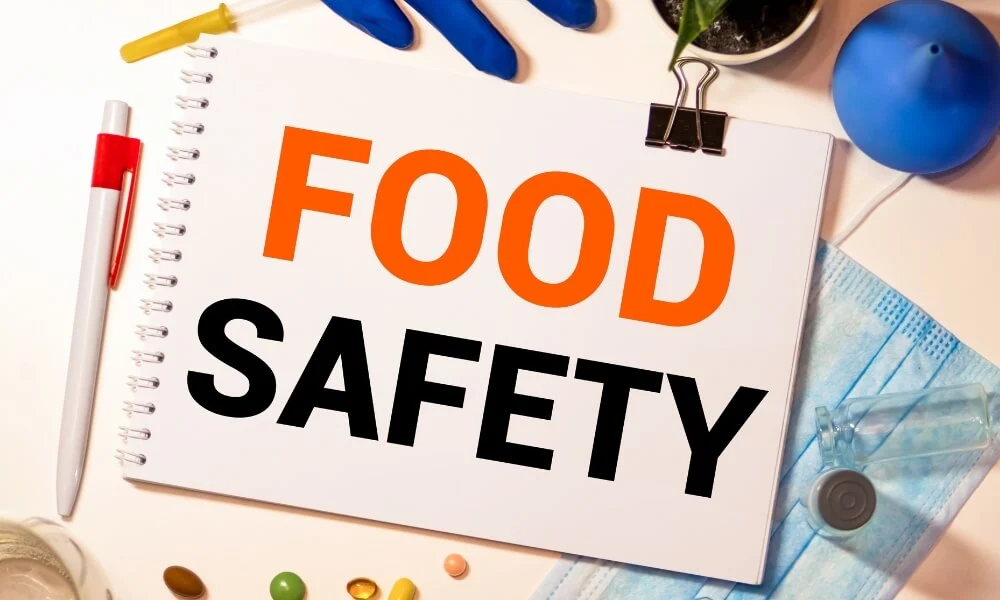In today’s globalized world, where food products traverse continents before landing on our plates, ensuring their safety has become more crucial than ever. The intricacies of the food supply chain, combined with the diverse array of ingredients sourced from different regions, underscore the need for a robust system to monitor and ensure food safety. Welcome to our blog on the Food Safety Management System (FSMS), a linchpin in the modern food industry. This post will delve deep into the definition of FSMS and unravel its essential elements.
Whether you are a part of the food industry, a budding entrepreneur, or a consumer curious about the measures taken to ensure the safety of your food, this comprehensive guide will provide you with valuable insights into the mechanisms that underpin food safety in the 21st century. Join us as we journey through the core components that ensure every bite you take is delicious but also safe and sound.
Food Safety Management System (FSMS)
Food Safety Management System (FSMS) is a systematic approach to controlling food safety hazards within a food business to ensure food is safe to consume. It encompasses a combination of practices, procedures, and processes to ensure food products’ safety from production to consumption. This includes analyzing and controlling biological, chemical, and physical hazards from raw material production, procurement, handling, and manufacturing to distribution and consumption.

The importance of a Food Safety Management System (FSMS)
- Consumer Protection: At the core of FSMS is the protection of consumers from food-borne illnesses and ensuring that they receive food that is safe to consume. This aids in building trust with consumers, which is crucial for the reputation and sustainability of a food business.
- Regulatory Compliance: Many countries have set mandatory regulations and standards regarding food safety. An effective FSMS helps businesses comply with these regulations, avoiding legal repercussions, penalties, and potential business shutdowns.
- Economic Significance: An outbreak of foodborne illness traced back to a particular business can lead to massive financial losses due to recalls, legal actions, and a tarnished brand reputation. Implementing a robust FSMS can prevent such scenarios and ensure business continuity.
- Operational Efficiency: By implementing an FSMS, food businesses can achieve better operational efficiency. It allows for identifying and rectifying process inefficiencies, reducing waste, and optimizing resource usage.
- Supply Chain Assurance: FSMS gives assurance not just to end consumers but also to other businesses in the supply chain. For instance, retailers want assurance that the products they get from manufacturers meet certain safety standards.
- Access to New Markets: Many international markets demand adherence to specific food safety standards. An established FSMS can open doors for businesses to access and establish themselves in these markets.
- Continuous Improvement: FSMS operates on principles that encourage continuous monitoring and improvement. This ensures that the food business stays updated with the latest food safety standards and technologies, leading to better products and processes.
A Food Safety Management System is indispensable in today’s globalized world, where the food supply chain has become complex. It provides a structured way of ensuring food safety and enhances the credibility of businesses in the eyes of consumers, regulators, and partners.

10 Key Elements of Food Safety Management System (FSMS)
A Food Safety Management System (FSMS) is an integral part of the food production process, ensuring the safety and suitability of food for consumption. Here are the 10 key elements of an FSMS:
1. Food Safety Policy and Objectives
A food safety policy is essentially a statement from the organization’s top management outlining its commitment to uphold and ensure the safety of the products they produce. This policy acts as a foundation upon which the entire FSMS is built. The policy should be clear, concise, and accessible to all staff members. It should be regularly reviewed and updated as necessary.
Beyond this policy, specific food safety objectives need to be established. These objectives are targets and goals set to improve food safety performance, and they should be measurable, achievable, and time-bound. Together, the policy and objectives act as guiding principles that steer the organization towards continuous improvement in food safety.
2. Hazard Analysis and Critical Control Point (HACCP)
HACCP is a science-based system central to food safety. It begins with a thorough analysis where potential food safety hazards – be they biological, chemical, or physical – are identified. Once these hazards are recognized, the process determines the specific points in the production where these risks can be controlled, called the Critical Control Points (CCPs).
By monitoring and managing these CCPs, businesses can prevent, reduce, or eliminate potential safety risks. These CCPs must clearly define limits; when these limits are breached, corrective actions must be in place to address the deviations.
3. Prerequisite Programs (PRPs)
Before diving into the specifics of HACCP, some fundamental practices and conditions need to be in place, known as Prerequisite Programs. PRPs form the backdrop of a hygienic environment. They can range from basic sanitary practices, pest control, and waste management to maintaining facilities and equipment.
These programs might not control specific hazards like HACCP, but they ensure a base level of conditions that minimize the chance of contamination and other food safety risks.

4. Management Responsibility
Any FSMS’s success heavily relies on top management’s commitment and leadership. Management must be actively involved, showing that food safety is a priority. Their responsibilities encompass providing all the necessary resources – finances, equipment, or personnel – to implement and uphold the FSMS.
Management is also responsible for clearly defining roles within the organization, ensuring everyone knows their responsibilities and has the authority to carry them out. Effective vertical and horizontal communication within the organization ensures alignment and understanding of the FSMS across all levels.
5. Resource Management
To effectively implement and maintain an FSMS, there is a need for adequate resources. Human resources play a pivotal role. Employees should be properly trained and equipped with the knowledge and skills pertinent to food safety. Moreover, the physical facilities and infrastructure, including the production environment, storage areas, and equipment, must be aptly designed, maintained, and upgraded as necessary.
The adequacy and efficiency of these resources directly influence the success of the FSMS and, by extension, the safety of the food products. Proper resource management ensures the organization is well-prepared to tackle food safety challenges head-on.
6. Planning and Realization of Safe Products
Planning and realizing safe products is a comprehensive approach encompassing the entire journey of a food product, from the very beginning to its final consumption. This starts with sourcing raw materials to meet set quality and safety standards.
Once these materials are procured, the production process must be meticulously overseen to maintain the safety and integrity of the product. This includes proper handling, processing, and packaging. After production, the storage conditions should be optimal to prevent contamination or degradation.
Finally, the delivery or distribution mechanism should guarantee that the product reaches the consumer without compromising its safety. Potential hazards must be anticipated and controlled at every stage, ensuring that the end product is safe for consumption and compliant with relevant regulations and standards.

7. Validation, Verification, and Improvement of the FSMS
For a Food Safety Management System to be effective, it cannot be static; it must be dynamic and evolving. Validation ensures that the controls are scientifically sound and capable of controlling the identified hazards. Once in place, these controls must be verified, which means regularly checking and confirming that they are working as intended. Tools like audits, both internal and third-party, play a pivotal role in this verification process.
However, the journey doesn’t end with verification. Based on the feedback from these checks, the FSMS should be continually improved. This improvement can arise from learning from mistakes, adapting to changes in the production environment, or embracing new technologies and methods. A proactive approach to refining and enhancing the FSMS ensures the system remains robust and responsive.
8. Traceability, Recall, and Withdrawal
In the event of an unforeseen food safety incident, the ability to trace a product back through its entire lifecycle is invaluable. Traceability systems enable a business to identify the origin of a problem and can help prevent further contamination or harm. However, knowing the source of an issue is only one part; acting on it is equally vital.
This is where recall and withdrawal procedures come into play. Should a product be identified as potentially harmful, having a swift and effective recall system ensures that it can be quickly removed from the market, minimizing potential harm to consumers. Such procedures should be well-planned, tested, and communicated to all relevant stakeholders to ensure rapid execution when required.
9. Communication
The cornerstone of a successful FSMS is effective communication. Internally, every organization member, from the top management to the frontline workers, should be on the same page regarding food safety practices and protocols. This alignment ensures seamless operations and quick response to any arising issues.
Externally, it’s essential to maintain open lines of communication with stakeholders like suppliers, customers, and regulatory authorities. This ensures everyone in the supply chain is aware of and adhering to the necessary safety standards. Transparent communication builds trust, promotes collaboration, and is often the first defense against potential food safety threats.

10. Documentation and Record Keeping
Documenting processes, procedures, and activities related to food safety serves multiple purposes. Firstly, it provides a clear blueprint for how certain tasks and operations should be conducted. This consistency is crucial for maintaining safety standards. Secondly, records act as evidence of compliance. Whether it’s a log of temperature checks, cleaning schedules, or records of training sessions, such documentation can be invaluable during audits or inspections.
Furthermore, these records can be reviewed in case of an incident to understand what went wrong and how to prevent it. In essence, proper documentation and record-keeping are both the memory and the conscience of an FSMS, reflecting past actions and guiding future ones.
Conclusion
In the intricate tapestry of the global food supply chain, the Food Safety Management System (FSMS) stands out as a beacon of assurance, ensuring that our food is safe and of the highest quality. Through its meticulously designed processes, procedures, and practices, FSMS offers a systematic approach to mitigating potential hazards, from the raw material’s inception to its transformation into the final product on our tables.
The various elements of FSMS, as explored in this blog, emphasize its comprehensive nature and the industry’s unwavering commitment to consumer safety. As we conclude our journey into the world of FSMS, it becomes evident that food safety is not just a regulatory demand but an ethical responsibility. It’s a collaborative effort where every stakeholder is pivotal, from the farmer to the end consumer.
The next time you sit down for a meal, take a moment to appreciate the intricate systems that ensure each bite is as safe as it is delicious. Safe food is a universal right, and with FSMS, we move one step closer to ensuring it for everyone.

